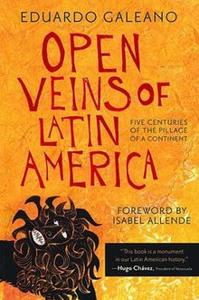
Want to learn the ideas in Open Veins Of Latin America better than ever? Read the world’s #1 book summary of Open Veins Of Latin America by Eduardo Galeano here.
Read a brief 1-Page Summary or watch video summaries curated by our expert team. Note: this book guide is not affiliated with or endorsed by the publisher or author, and we always encourage you to purchase and read the full book.
Video Summaries of Open Veins Of Latin America
We’ve scoured the Internet for the very best videos on Open Veins Of Latin America, from high-quality videos summaries to interviews or commentary by Eduardo Galeano.
1-Page Summary of Open Veins Of Latin America
Overall Summary
Open Veins of Latin America is a book about the history and current state of politics in Latin America. The author, Eduardo Galeano, wrote this book to commemorate the 25th anniversary of its original publishing. This study guide refers to an updated version that was published in 1997, translated by Cedric Belfrage.
The book Open Veins of Latin America by Eduardo Galeano is about the exploitation of Latin American resources. He discusses how the region was first discovered and how it became a major part of the world economy, as well as what happened when US companies took over from European ones. The author also reflects on seven years after his book’s publication in which he talks about politics in South America.
In part 1, Galeano discusses how the Spanish colonization of Latin America led to exploitation of its resources. The arrival of the Spanish brought violence, disease and forced labor to native people in Latin America. Eventually Europeans would mine for gold, silver, tin and petroleum before forcing a monoculture of sugar and coffee production on them.
The Spanish and British were the most influential Western countries in Latin America, but eventually the United States took over. Capitalism evolved into a global market that enabled the US to use protectionist policies for itself while wielding power through international organizations such as the International Monetary Fund (IMF) and World Bank to keep other countries economically dependent on it.
Part 3 of the book is a 25th anniversary addition to the original book. It includes Galeano’s reflections on how political and economic circumstances have worsened over time, despite some gains in social equality. He remains hopeful that there are enough examples throughout history of resistance led by marginalized people to encourage future structural change.
Introduction: “120 Million Children in the Eye of the Hurricane”
In the introduction of Open Veins of Latin America, Eduardo Galeano describes Latin America as “the region with open veins” because all its resources flow outwards to the US and Europe. He proceeds to discuss how this relationship developed over time.
In 1961, President John F. Kennedy established the Alliance for Progress to help Latin America economically by giving them money through loan programs. However, this system of aid ultimately created a dependency between the US and Latin America. This is because colonialism had already set a precedent of economic exploitation in Latin America, which continues today with larger countries controlling smaller ones. The result is a complicated system of inequities that has its roots in colonialism and continues into present day as an endless chain of dependency.
The United States and Europe view Latin America as a region that exists to serve their needs. The US views Latin America as a second-class country, which is not truly an independent nation but rather one that is controlled by the US. As populations in Latin American countries continue to grow, they become more desperate and less able to improve their living conditions or resources. Yet for the US, population growth in these countries signals a higher probability of revolution against them; this could disrupt the economic control of the area.
Galeano proposes that revolution is the only way to change Latin America. He cites Cuba’s socialist government under Fidel Castro as an example of how to move away from foreign aid towards economic independence, and he insists that revolution is the only way to recover what Latin America has lost due to US and European intervention.






